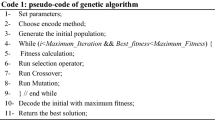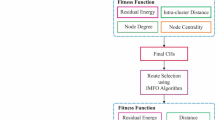Abstract
Advancements in wireless communication technologies have facilitated the deployment of large-scale Wireless Sensor Networks (WSNs). Due to the constraint of associated battery power, various optimization structures have been proposed to enhance the lifetime of WSNs. In this article, the concept of supernodes is used along with Moth Flame Optimization algorithm to improve the lifetime of the heterogeneous WSNs. The Moth Flame Optimization algorithm is used to achieve the energy-efficient clustering and energy-aware routing. The performance of Moth Flame Optimization algorithm is compared with the other existing protocol, including Genetic Algorithm and Particle Swarm Optimization algorithm. The effects of varying populations of supernodes and sensor nodes on the network metrics are also analyzed here. The influence of the number of hops on the lifetime is also investigated considering two different positions of the base-station in WSNs.






Similar content being viewed by others
References
Lombardo, L., Corbellini, S., Parvis, M., Elsayed, A., Angelini, E., & Grassini, S. (2001). Wireless sensor network for distributed environmental monitoring. IEEE Transactions on Instrumentation and Measurement, 67(5), 1214–1222.
Li, K., Ni, W., Duan, L., Abolhasan, M., & Niu, J. (2018). Wireless power transfer and data collection in wireless sensor networks. IEEE Transactions on Vehicular Technology, 67(3), 2686–2697.
Arif, M., Wang, G., & Balas, V. E. (2018). Secure VANETs: Trusted communication scheme between vehicles and infrastructure based on fog computing. Studies in Informatics and Control, 27(2), 235–246.
Cao, N., Choi, S., Masazade, E., & Varshney, P. K. (2016). Sensor selection for target tracking in wireless sensor networks with uncertainty. IEEE Transactions on Signal Processing, 64(20), 5191–5204.
Fu, Y., Ling, Q., & Tian, Z. (2012). Distributed sensor allocation for multi-target tracking in wireless sensor networks. IEEE Transactions on Aerospace and Electronic Systems, 48(4), 3538–3553.
Guo, P., Liu, X., Cao, J., & Tang, S. (2017). Lossless in-network processing and its routing design in wireless sensor networks. IEEE Transactions on Wireless Communications, 16(10), 6528–6542.
Guo, W., Li, J., Chen, G., Niu, Y., & Chen, C. (2015). A PSO-optimized real-time fault-tolerant task allocation algorithm in wireless sensor networks. IEEE Transactions on Parallel and Distributed System, 26(12), 3236–3239.
Wang, D., Zhang, R., Cheng, X., Quan, Z., & Yang, L. (2017). Joint power allocation and splitting (JoPAS) for SWIPT in doubly selective vehicular channels. IEEE Transactions on Green Communication and Networks, 1(4), 494–502.
Luo, S., Xu, J., Lim, T. J., & Zhang, R. (2015). Capacity region of MISO broadcast channel for simultaneous wireless information and power transfer. IEEE Transactions on Communication, 63(10), 3856–3868.
Masazade, E., & Kose, A. (2018). A proportional time allocation algorithm to transmit binary sensor decisions for target tracking in a wireless sensor network. IEEE Transactions on Signal Processing, 66(1), 86–100.
Agrawal, A., Singha, V., Jain, S., & Gupta, R. K. (2018). GCRP: Grid-cycle routing protocol for wireless sensor network with mobile sink. International Journal of Electronics and Communications, 94, 1–11.
Wang, C., Guo, S., & Yang, Y. (2016). An optimization framework for mobile data collection in energy-harvesting wireless sensor networks. IEEE Transactions on Mobile Computing, 15(12), 2969–2986.
He, Y., He, X., & Wang, T. (2018). Neural network optimization for energy-optimal cooperative computing in wireless communication system. International Journal of Electronics and Communications, 93, 216–223.
Heinzelman, W. B., Chandrakasan, A. P., & Balakrishnan, H. (2002). An application specific protocol architecture for wireless micro-sensor networks. IEEE Transactions on Wireless and Communications., 1(4), 660–670.
Muruganathan, S. D., Ma, D. C. F., Bhasin, R. I., & Fapojuwo, A. O. (2005). A centralized energy-efficient routing protocol for wireless sensor networks. IEEE Radio Communications., 43(3), 8–13.
Villas, L. A., Boukerche, A., Ramos, H. S., Oliveira, H. A. B. F., Araujo, R. B., & Loureiro, F. A. A. (2012). DRINA: A lightweight and reliable routing approach for in-network aggregation in wireless sensor networks. IEEE Transactions on comput., 62(4), 676–689.
Xie, D., Zhou, Q., You, X., Li, B., & Yuan, X. (2013). A novel energy-efficient cluster formation strategy: From the perspective of cluster members. IEEE Communications Letters, 17(11), 2044–2047.
Yildiz, H. U., Ciftler, B. S., Tavli, B., Bicakci, K., & Incebacak, D. (2018). The impact of incomplete secure connectivity on the lifetime of wireless sensor networks. IEEE Systems Journal, 12(1), 1042–1046.
Mekikis, P. V., Kartsakli, E., Antonopoulos, A., Alonso, L., & Verikoukis, C. (2018). Connectivity analysis in clustered wireless sensor networks powered by solar energy. IEEE Transactions on Wireless Communications, 17(4), 2389–2401.
Mridula, K. M., & Ameer, P. M. (2018). Three-dimensional sensor network connectivity considering border effects and channel randomness with application to underwater networks. IET Communications, 12(8), 994–1002.
Kuila, P., & Jana, P. K. (2014). Energy efficient clustering and routing algorithms for wireless sensor networks: Particle swarm optimization approach. Engineering Applications of Artificial Intelligence, 33, 127–140.
Chand, K. K., Bharati, P. V. & Ramanjaneyulu, B. S. (2012). Optimized energy efficient routing protocol for life-time improvement in wireless sensor networks. IEEE International Conference on Advances in Engineering, Science and Management (ICAESM -2012), 345–349.
Parvin, R., & Vasanthanayaki, C. (2015). Particle swarm optimization-based clustering by preventing residual nodes in wireless sensor networks. IEEE Sensor Journal, 15(8), 4264–4274.
Kennedy, J. & Eberhart, R. (1995). Particle swarm optimization. Proceedings of ICNN'95 - International Conference on Neural Networks, Piscataway, 1942–1948.
Rashedi, E., Nezamabadi-pour, H. & Saryazdi, S. (2009). GSA: A gravitational search algorithm information sciences, 179(13), 2232–2248.
Britto, P. X., & Selvan, S. (2019). A hybrid soft computing: SGP clustering methodology for enhancing network lifetime in wireless multimedia sensor networks. Soft Computing, 23(8), 2597–2609.
Fradj, A. B., Anane, R., & Bouallegue, R. (2019). Opportunistic routing protocols in wireless sensor networks. Wireless Personal Communications, 104(3), 921–933.
Anandh, S. J., & Baburaj, E. (2020). Energy efficient routing technique for wireless sensor networks using ant-colony optimization. Wireless Personal Communications, 114(4), 3419–3433.
Mirjalili, S. (2015). Moth-Flame optimization algorithm: A novel nature-inspired heuristic paradigm. Knowledge-Based Systems, 89, 228–249.
Goldberg, D. E. (1989). Genetic algorithm in search, optimization and machine learning. New York: Addison.
Funding
None.
Author information
Authors and Affiliations
Corresponding author
Ethics declarations
Conflicts of interest
All authors declares that they have no conflict of interest.
Additional information
Publisher's Note
Springer Nature remains neutral with regard to jurisdictional claims in published maps and institutional affiliations.
Rights and permissions
About this article
Cite this article
Pandey, A., Rajan, A., Nandi, A. et al. Lifetime Enhancement of Sensor Networks by the Moth Flame Optimization. Wireless Pers Commun 118, 2807–2820 (2021). https://doi.org/10.1007/s11277-021-08156-1
Accepted:
Published:
Issue Date:
DOI: https://doi.org/10.1007/s11277-021-08156-1




